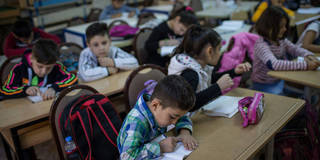With new financing tools at their disposal, social entrepreneurs can help to improve the Middle East's schools and curricula. The region’s public and nonprofit sectors need only recognize the promise of social enterprise in education, and create the conditions for entrepreneurs to succeed.
LONDON – Supporting the millions of newly displaced people of the Middle East demands resources far beyond the capacity of the United Nations, and is a continuous humanitarian-aid challenge for companies, foundations, and public-sector donors. While UN peacekeepers are financed by a system of “assessed contributions,” humanitarian aid depends on voluntary donations. Education, which is prioritized below basic survival needs like food and shelter, all too often gets left behind.

LONDON – Supporting the millions of newly displaced people of the Middle East demands resources far beyond the capacity of the United Nations, and is a continuous humanitarian-aid challenge for companies, foundations, and public-sector donors. While UN peacekeepers are financed by a system of “assessed contributions,” humanitarian aid depends on voluntary donations. Education, which is prioritized below basic survival needs like food and shelter, all too often gets left behind.